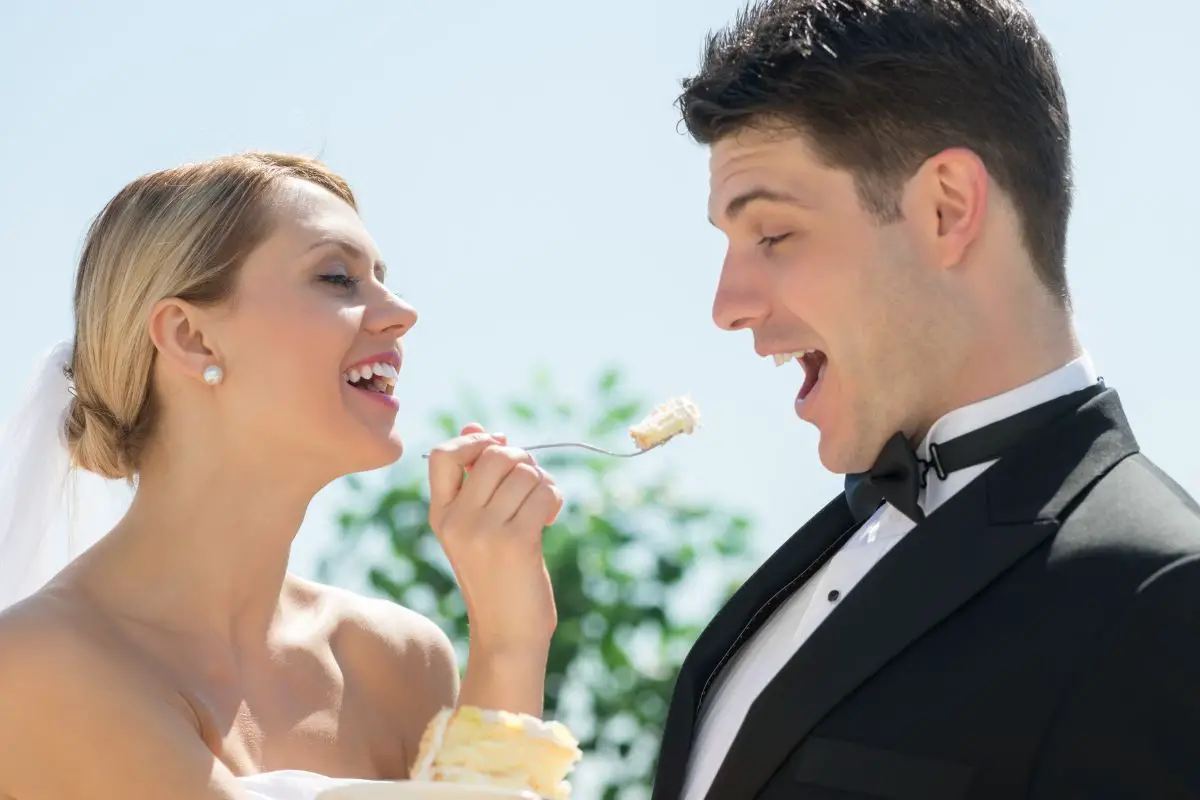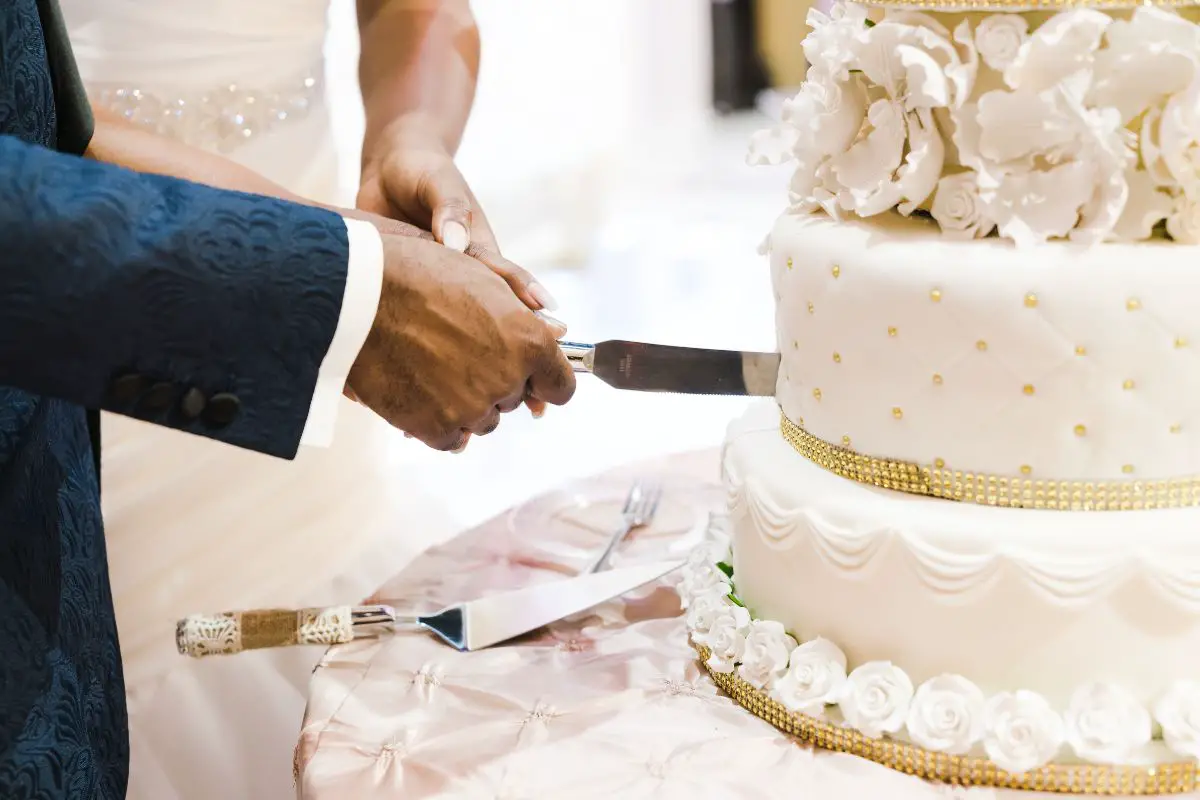When it comes to wedding celebrations, there are numerous different traditions that have a long history within western matrimony – many of which are surprisingly still observed in modern day.

While they may not have the same implications, or indeed the same level of importance as they once did centuries ago, they provide a wholesome, enjoyable framework for the married couple to base their day around – and are overall a good way of making happy memories on the special day.
One such tradition is the couple feeding one another wedding cake. But why exactly do they do this, and what meaning does it convey?
Why Do They Feed Wedding Cake?
Generally speaking, the tradition of the married couple feeding one another cake – at least in modern practice – is supposed to symbolize their unity, their first unified act as a couple, as well as their love and commitment to one another.
The latter in particular follows on from the ‘in sickness and in health’ part of the Christian wedding vows, wherein the partners promise to care for one another for the rest of their married lives together.
As such, the act of feeding each other not only shows cooperation, but also commitment to literally nourish one another with love, time, affection, and support.
What Is The Historical Significance?
Historically, there have been many different traditions and symbolistic imagery surrounding the wedding cake, and while this has changed over time, there are still some parts that are observed today.
Sharing the wedding cake, and serving each other a mouthful is considered to be one of these traditions, and historically it very much shared a similar message to what it does today – that is, one of providing for one another, both in a financial sense, as well as in terms of love and companionship.
Why Are Wedding Cakes So Important?
Historically speaking, the wedding cake has always been significant, having distinct importance to the overall ceremony, the future happiness of the couple, as well as the romantic prospects of the guests themselves.
This is because of the shared nature of the wedding cake – with the thought being that people are coming together to celebrate and provide blessings for the union of two people, and in doing so, they are taking a little of the good luck, merriment, and fortune for themselves in their own future romantic endeavors.
This can be seen in several of the associated traditions with historical wedding celebrations, with each highlighting the perceived importance of offering goodwill and support to the loved ones taking this journey together.
What Other Lucky Traditions Are There?
As mentioned above, there have been numerous wedding cake traditions throughout the centuries – some that have faded into obscurity over time, and others that have come together to form the framework of the modern matrimonial belief system.
Sharing The Cake
First and foremost, the idea of the wedding cake has always been associated with good luck – and this manifested itself in many different traditions.
As a shared dish amongst the guests, the cake became something of a covenant taken by all the guests at a wedding – each offering their blessing and honest well wishes, and thus sealing the deal and making it so by taking a piece of the cake.
Throughout Europe, wedding traditions have long required all the guests to take a piece of cake to wish their blessings on the couple getting married.
This practice even predates the presence of a sweet cake, with ceremonies in central Europe consisting of a shared wedding pie – made from oysters, lamb’s testicles, pine nut kernels, and other forms of meat and fish that would today seem undesirable.
This would be shared amongst everyone in attendance, and became a regularly celebrated tradition.

Breaking The Cake
In ancient Rome, it was tradition for the guests to break the sweetened cake (usually made from barley and wheat) above the bride’s head.
This was not only seen as a source of good luck, but also promised that the marriage could withstand whatever damage would befall it – the cracks and breakages of relationships seemingly being represented by the breaking of the cake (see also: How To Fix Cracks And Hard Top On Cake?)itself.
This is not observed today – at least not in the mainstream – but there are similar practices that would appear to follow the same mentality.
Hidden Rings
In medieval England – as well as throughout Europe – it was long considered tradition to hide a glass (or sometimes metal) ring inside the cake.
When this cake was then cut, and shared out amongst the guests – usually the young women – the woman who found the ring would be predicted to be the next one to get married.
This was not only seen as a sign of good luck for the woman involved, but also as a sign of passing on the blessings and good fortune of the day with other people.
It was also a supposed guarantee of fertility, happiness, and a fortunate future of romance and prosperity.
This is continued today – albeit in the form of a bouquet, wherein the bride throws it over her shoulder to the unmarried women at the wedding.
Whomever should catch the bouquet is considered the next one to be getting married – however, this is less of a good luck tradition, and more of a nice, lighthearted, and wholesome event to share with guests.
Hidden Compartments
Wedding cakes would also have hidden compartments, wherein there would be live birds (such as doves), or even other animals like snakes.
This was seen as a source of entertainment for the guests – especially in Medieval England – and was all a part of bringing everyone together in shared excitement.
This is very much related to the notion of the cake as a unifying dish – one that would be shared in the way of the cake being eaten, being enjoyed as entertainment, and being observed as the centerpiece of the big day.
The latter part of this tradition has been continued into modern times, and it is common for the wedding cake to have pride and place – not only on the table itself, but also within the celebrations and reception.
This is represented by the expense that people will go to for their cake, and the associated honor that still comes with receiving a piece.
Are Wedding Cakes Still Popular?
In modern weddings, the cake is still an important part of proceedings, and while traditions may not hold as much weight as they once did, they are still a revered and much loved part of the big day.
Final Thoughts
And there we have it, everything you need to know about wedding day traditions, and the reasons why they remain so popular.
It’s true that, in most wedding ceremonies, traditions like feeding one another wedding cake remain ever popular for new couples – even when other traditions seem to fall by the wayside and become less common.
So if you are planning for your big day, and you want to be more traditional, then why not give this a try? Something tells me you won’t be disappointed!
- How To Make Honey Butter - July 4, 2023
- How To Make Meringue - July 3, 2023
- What Is Shortening? - July 3, 2023









Leave a comment